Civil Engineering Literature Review: Soil Stabilization with Polymers
VerifiedAdded on 2023/06/09
|8
|2837
|388
Literature Review
AI Summary
This literature review examines the use of polymers in soil stabilization, focusing on techniques and materials from 2000 to 2010. It analyzes four research papers addressing the stabilization of dispersive and expansive soils, emphasizing the benefits of chemical and mechanical processes. The review covers the application of polymers and biopolymers in arid and semi-arid regions for water retention and soil improvement. It also discusses various methods and materials used for soil stabilization, including lime, cement, and industrial wastes. The papers highlight the importance of soil stabilization in construction, improving the bearing capacity of soil materials through polymer application and other methods such as mechanical and chemical stabilization. The review provides insights into the properties of soil, the challenges of soil degradation, and the effectiveness of different stabilization approaches.
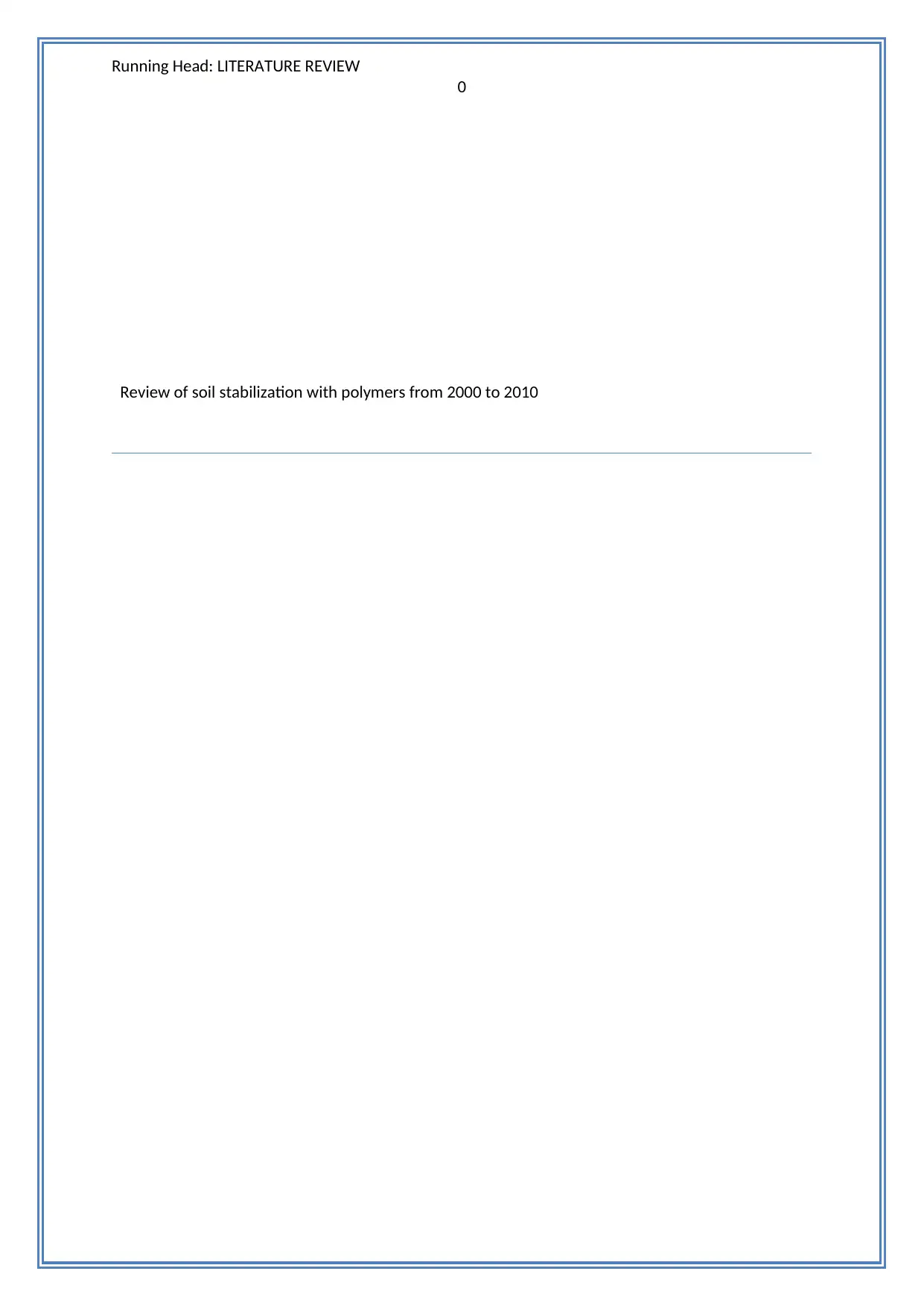
Running Head: LITERATURE REVIEW
0
Review of soil stabilization with polymers from 2000 to 2010
0
Review of soil stabilization with polymers from 2000 to 2010
Secure Best Marks with AI Grader
Need help grading? Try our AI Grader for instant feedback on your assignments.
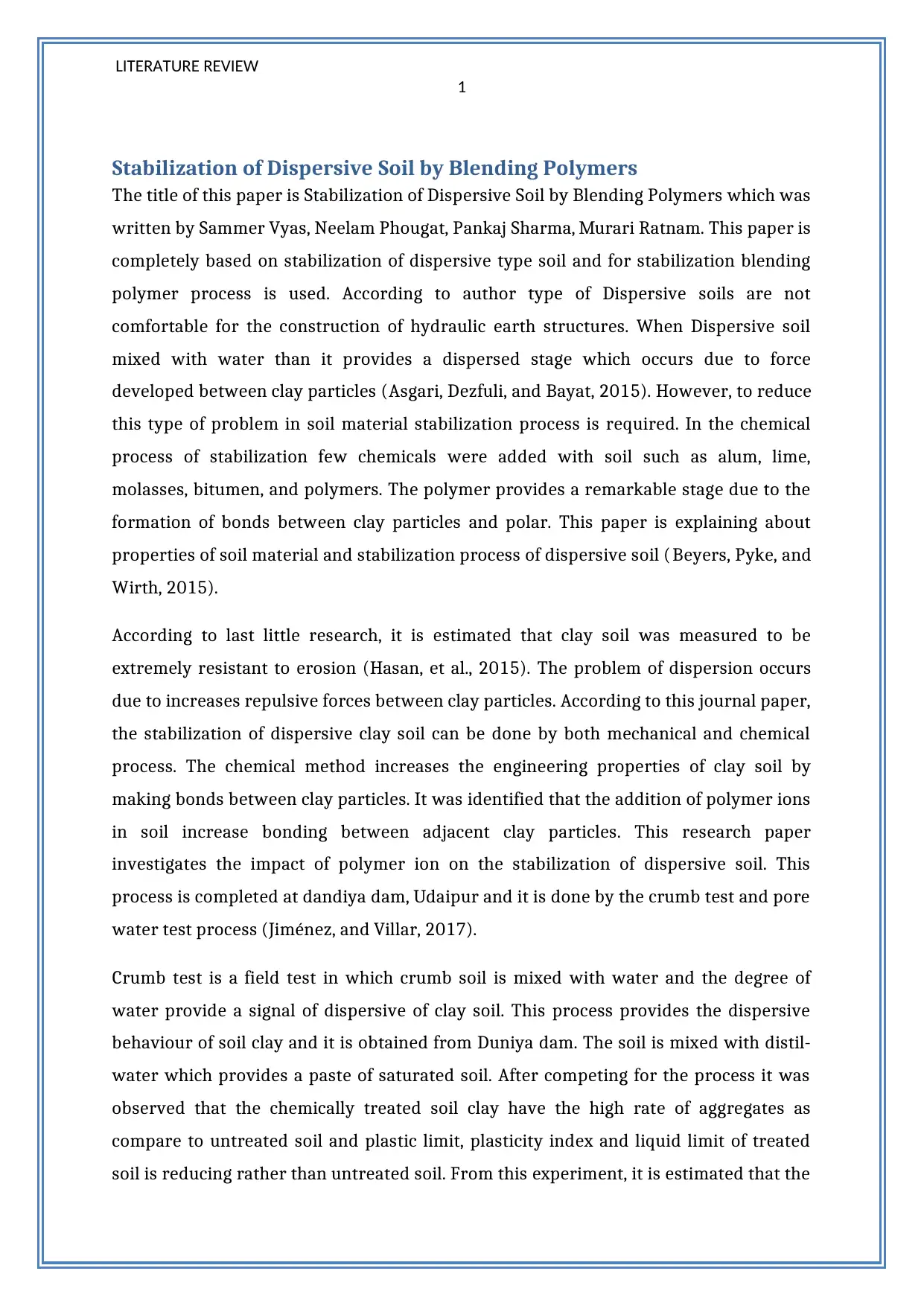
LITERATURE REVIEW
1
Stabilization of Dispersive Soil by Blending Polymers
The title of this paper is Stabilization of Dispersive Soil by Blending Polymers which was
written by Sammer Vyas, Neelam Phougat, Pankaj Sharma, Murari Ratnam. This paper is
completely based on stabilization of dispersive type soil and for stabilization blending
polymer process is used. According to author type of Dispersive soils are not
comfortable for the construction of hydraulic earth structures. When Dispersive soil
mixed with water than it provides a dispersed stage which occurs due to force
developed between clay particles (Asgari, Dezfuli, and Bayat, 2015). However, to reduce
this type of problem in soil material stabilization process is required. In the chemical
process of stabilization few chemicals were added with soil such as alum, lime,
molasses, bitumen, and polymers. The polymer provides a remarkable stage due to the
formation of bonds between clay particles and polar. This paper is explaining about
properties of soil material and stabilization process of dispersive soil (Beyers, Pyke, and
Wirth, 2015).
According to last little research, it is estimated that clay soil was measured to be
extremely resistant to erosion (Hasan, et al., 2015). The problem of dispersion occurs
due to increases repulsive forces between clay particles. According to this journal paper,
the stabilization of dispersive clay soil can be done by both mechanical and chemical
process. The chemical method increases the engineering properties of clay soil by
making bonds between clay particles. It was identified that the addition of polymer ions
in soil increase bonding between adjacent clay particles. This research paper
investigates the impact of polymer ion on the stabilization of dispersive soil. This
process is completed at dandiya dam, Udaipur and it is done by the crumb test and pore
water test process (Jiménez, and Villar, 2017).
Crumb test is a field test in which crumb soil is mixed with water and the degree of
water provide a signal of dispersive of clay soil. This process provides the dispersive
behaviour of soil clay and it is obtained from Duniya dam. The soil is mixed with distil-
water which provides a paste of saturated soil. After competing for the process it was
observed that the chemically treated soil clay have the high rate of aggregates as
compare to untreated soil and plastic limit, plasticity index and liquid limit of treated
soil is reducing rather than untreated soil. From this experiment, it is estimated that the
1
Stabilization of Dispersive Soil by Blending Polymers
The title of this paper is Stabilization of Dispersive Soil by Blending Polymers which was
written by Sammer Vyas, Neelam Phougat, Pankaj Sharma, Murari Ratnam. This paper is
completely based on stabilization of dispersive type soil and for stabilization blending
polymer process is used. According to author type of Dispersive soils are not
comfortable for the construction of hydraulic earth structures. When Dispersive soil
mixed with water than it provides a dispersed stage which occurs due to force
developed between clay particles (Asgari, Dezfuli, and Bayat, 2015). However, to reduce
this type of problem in soil material stabilization process is required. In the chemical
process of stabilization few chemicals were added with soil such as alum, lime,
molasses, bitumen, and polymers. The polymer provides a remarkable stage due to the
formation of bonds between clay particles and polar. This paper is explaining about
properties of soil material and stabilization process of dispersive soil (Beyers, Pyke, and
Wirth, 2015).
According to last little research, it is estimated that clay soil was measured to be
extremely resistant to erosion (Hasan, et al., 2015). The problem of dispersion occurs
due to increases repulsive forces between clay particles. According to this journal paper,
the stabilization of dispersive clay soil can be done by both mechanical and chemical
process. The chemical method increases the engineering properties of clay soil by
making bonds between clay particles. It was identified that the addition of polymer ions
in soil increase bonding between adjacent clay particles. This research paper
investigates the impact of polymer ion on the stabilization of dispersive soil. This
process is completed at dandiya dam, Udaipur and it is done by the crumb test and pore
water test process (Jiménez, and Villar, 2017).
Crumb test is a field test in which crumb soil is mixed with water and the degree of
water provide a signal of dispersive of clay soil. This process provides the dispersive
behaviour of soil clay and it is obtained from Duniya dam. The soil is mixed with distil-
water which provides a paste of saturated soil. After competing for the process it was
observed that the chemically treated soil clay have the high rate of aggregates as
compare to untreated soil and plastic limit, plasticity index and liquid limit of treated
soil is reducing rather than untreated soil. From this experiment, it is estimated that the
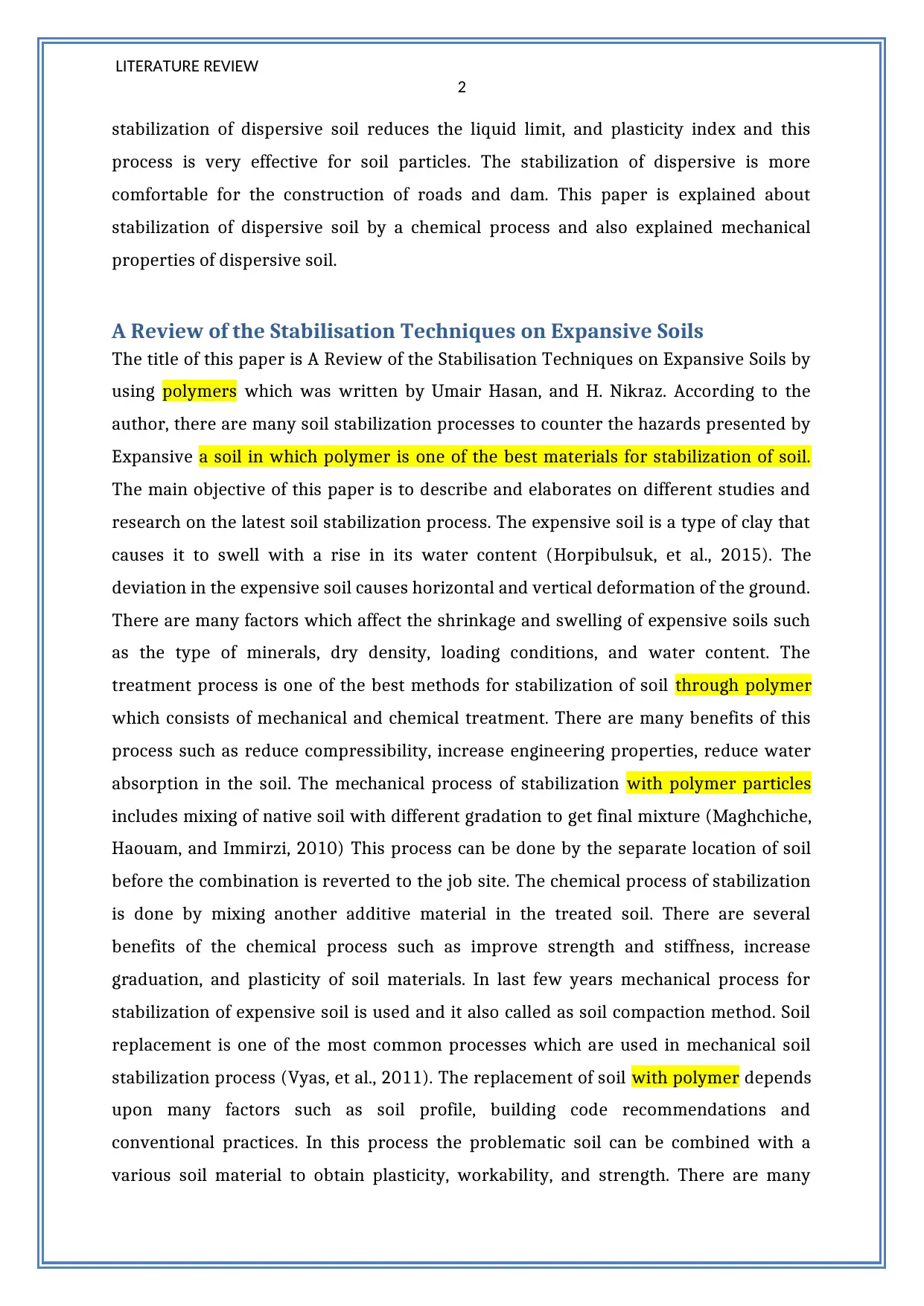
LITERATURE REVIEW
2
stabilization of dispersive soil reduces the liquid limit, and plasticity index and this
process is very effective for soil particles. The stabilization of dispersive is more
comfortable for the construction of roads and dam. This paper is explained about
stabilization of dispersive soil by a chemical process and also explained mechanical
properties of dispersive soil.
A Review of the Stabilisation Techniques on Expansive Soils
The title of this paper is A Review of the Stabilisation Techniques on Expansive Soils by
using polymers which was written by Umair Hasan, and H. Nikraz. According to the
author, there are many soil stabilization processes to counter the hazards presented by
Expansive a soil in which polymer is one of the best materials for stabilization of soil.
The main objective of this paper is to describe and elaborates on different studies and
research on the latest soil stabilization process. The expensive soil is a type of clay that
causes it to swell with a rise in its water content (Horpibulsuk, et al., 2015). The
deviation in the expensive soil causes horizontal and vertical deformation of the ground.
There are many factors which affect the shrinkage and swelling of expensive soils such
as the type of minerals, dry density, loading conditions, and water content. The
treatment process is one of the best methods for stabilization of soil through polymer
which consists of mechanical and chemical treatment. There are many benefits of this
process such as reduce compressibility, increase engineering properties, reduce water
absorption in the soil. The mechanical process of stabilization with polymer particles
includes mixing of native soil with different gradation to get final mixture (Maghchiche,
Haouam, and Immirzi, 2010) This process can be done by the separate location of soil
before the combination is reverted to the job site. The chemical process of stabilization
is done by mixing another additive material in the treated soil. There are several
benefits of the chemical process such as improve strength and stiffness, increase
graduation, and plasticity of soil materials. In last few years mechanical process for
stabilization of expensive soil is used and it also called as soil compaction method. Soil
replacement is one of the most common processes which are used in mechanical soil
stabilization process (Vyas, et al., 2011). The replacement of soil with polymer depends
upon many factors such as soil profile, building code recommendations and
conventional practices. In this process the problematic soil can be combined with a
various soil material to obtain plasticity, workability, and strength. There are many
2
stabilization of dispersive soil reduces the liquid limit, and plasticity index and this
process is very effective for soil particles. The stabilization of dispersive is more
comfortable for the construction of roads and dam. This paper is explained about
stabilization of dispersive soil by a chemical process and also explained mechanical
properties of dispersive soil.
A Review of the Stabilisation Techniques on Expansive Soils
The title of this paper is A Review of the Stabilisation Techniques on Expansive Soils by
using polymers which was written by Umair Hasan, and H. Nikraz. According to the
author, there are many soil stabilization processes to counter the hazards presented by
Expansive a soil in which polymer is one of the best materials for stabilization of soil.
The main objective of this paper is to describe and elaborates on different studies and
research on the latest soil stabilization process. The expensive soil is a type of clay that
causes it to swell with a rise in its water content (Horpibulsuk, et al., 2015). The
deviation in the expensive soil causes horizontal and vertical deformation of the ground.
There are many factors which affect the shrinkage and swelling of expensive soils such
as the type of minerals, dry density, loading conditions, and water content. The
treatment process is one of the best methods for stabilization of soil through polymer
which consists of mechanical and chemical treatment. There are many benefits of this
process such as reduce compressibility, increase engineering properties, reduce water
absorption in the soil. The mechanical process of stabilization with polymer particles
includes mixing of native soil with different gradation to get final mixture (Maghchiche,
Haouam, and Immirzi, 2010) This process can be done by the separate location of soil
before the combination is reverted to the job site. The chemical process of stabilization
is done by mixing another additive material in the treated soil. There are several
benefits of the chemical process such as improve strength and stiffness, increase
graduation, and plasticity of soil materials. In last few years mechanical process for
stabilization of expensive soil is used and it also called as soil compaction method. Soil
replacement is one of the most common processes which are used in mechanical soil
stabilization process (Vyas, et al., 2011). The replacement of soil with polymer depends
upon many factors such as soil profile, building code recommendations and
conventional practices. In this process the problematic soil can be combined with a
various soil material to obtain plasticity, workability, and strength. There are many
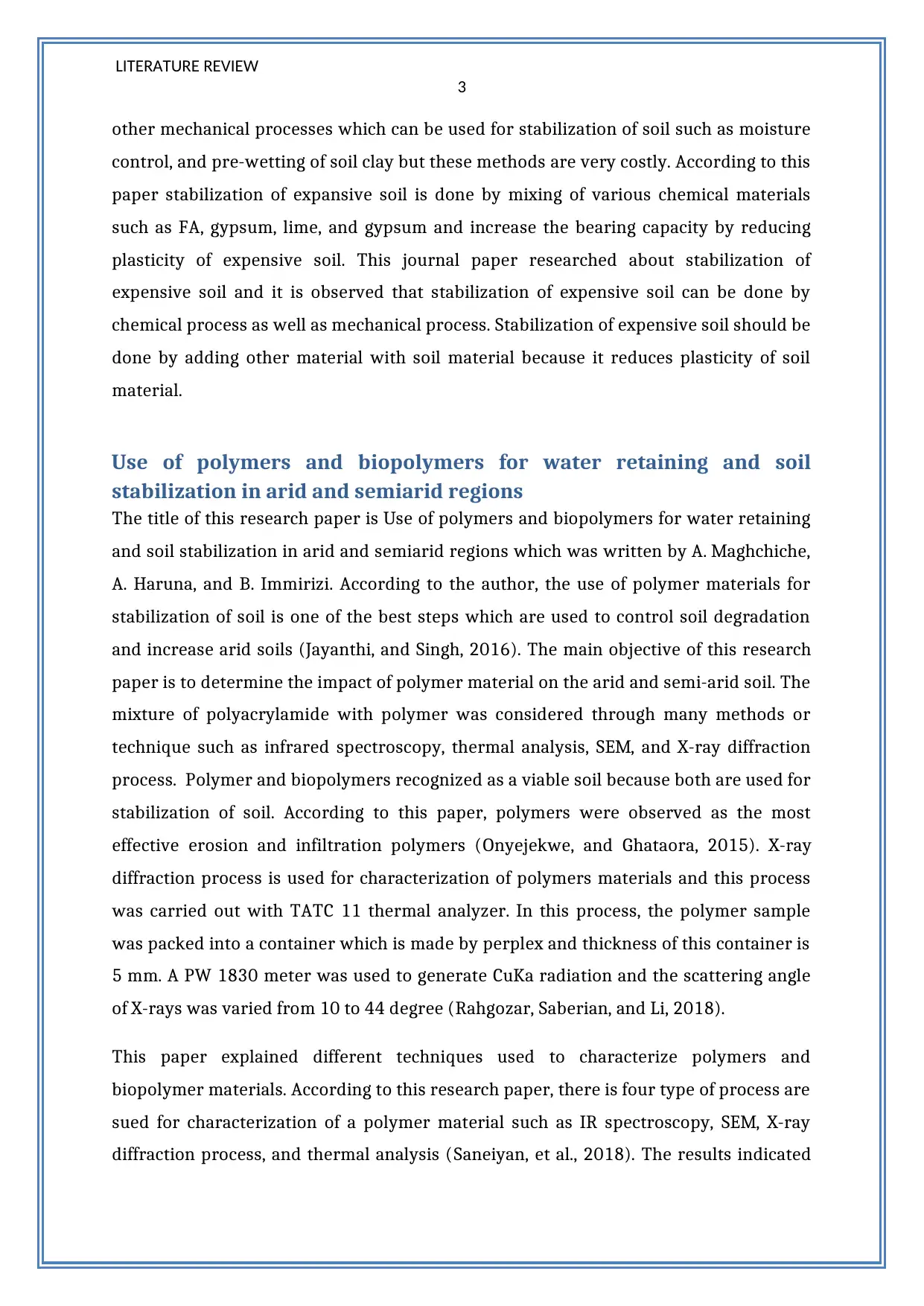
LITERATURE REVIEW
3
other mechanical processes which can be used for stabilization of soil such as moisture
control, and pre-wetting of soil clay but these methods are very costly. According to this
paper stabilization of expansive soil is done by mixing of various chemical materials
such as FA, gypsum, lime, and gypsum and increase the bearing capacity by reducing
plasticity of expensive soil. This journal paper researched about stabilization of
expensive soil and it is observed that stabilization of expensive soil can be done by
chemical process as well as mechanical process. Stabilization of expensive soil should be
done by adding other material with soil material because it reduces plasticity of soil
material.
Use of polymers and biopolymers for water retaining and soil
stabilization in arid and semiarid regions
The title of this research paper is Use of polymers and biopolymers for water retaining
and soil stabilization in arid and semiarid regions which was written by A. Maghchiche,
A. Haruna, and B. Immirizi. According to the author, the use of polymer materials for
stabilization of soil is one of the best steps which are used to control soil degradation
and increase arid soils (Jayanthi, and Singh, 2016). The main objective of this research
paper is to determine the impact of polymer material on the arid and semi-arid soil. The
mixture of polyacrylamide with polymer was considered through many methods or
technique such as infrared spectroscopy, thermal analysis, SEM, and X-ray diffraction
process. Polymer and biopolymers recognized as a viable soil because both are used for
stabilization of soil. According to this paper, polymers were observed as the most
effective erosion and infiltration polymers (Onyejekwe, and Ghataora, 2015). X-ray
diffraction process is used for characterization of polymers materials and this process
was carried out with TATC 11 thermal analyzer. In this process, the polymer sample
was packed into a container which is made by perplex and thickness of this container is
5 mm. A PW 1830 meter was used to generate CuKa radiation and the scattering angle
of X-rays was varied from 10 to 44 degree (Rahgozar, Saberian, and Li, 2018).
This paper explained different techniques used to characterize polymers and
biopolymer materials. According to this research paper, there is four type of process are
sued for characterization of a polymer material such as IR spectroscopy, SEM, X-ray
diffraction process, and thermal analysis (Saneiyan, et al., 2018). The results indicated
3
other mechanical processes which can be used for stabilization of soil such as moisture
control, and pre-wetting of soil clay but these methods are very costly. According to this
paper stabilization of expansive soil is done by mixing of various chemical materials
such as FA, gypsum, lime, and gypsum and increase the bearing capacity by reducing
plasticity of expensive soil. This journal paper researched about stabilization of
expensive soil and it is observed that stabilization of expensive soil can be done by
chemical process as well as mechanical process. Stabilization of expensive soil should be
done by adding other material with soil material because it reduces plasticity of soil
material.
Use of polymers and biopolymers for water retaining and soil
stabilization in arid and semiarid regions
The title of this research paper is Use of polymers and biopolymers for water retaining
and soil stabilization in arid and semiarid regions which was written by A. Maghchiche,
A. Haruna, and B. Immirizi. According to the author, the use of polymer materials for
stabilization of soil is one of the best steps which are used to control soil degradation
and increase arid soils (Jayanthi, and Singh, 2016). The main objective of this research
paper is to determine the impact of polymer material on the arid and semi-arid soil. The
mixture of polyacrylamide with polymer was considered through many methods or
technique such as infrared spectroscopy, thermal analysis, SEM, and X-ray diffraction
process. Polymer and biopolymers recognized as a viable soil because both are used for
stabilization of soil. According to this paper, polymers were observed as the most
effective erosion and infiltration polymers (Onyejekwe, and Ghataora, 2015). X-ray
diffraction process is used for characterization of polymers materials and this process
was carried out with TATC 11 thermal analyzer. In this process, the polymer sample
was packed into a container which is made by perplex and thickness of this container is
5 mm. A PW 1830 meter was used to generate CuKa radiation and the scattering angle
of X-rays was varied from 10 to 44 degree (Rahgozar, Saberian, and Li, 2018).
This paper explained different techniques used to characterize polymers and
biopolymer materials. According to this research paper, there is four type of process are
sued for characterization of a polymer material such as IR spectroscopy, SEM, X-ray
diffraction process, and thermal analysis (Saneiyan, et al., 2018). The results indicated
Secure Best Marks with AI Grader
Need help grading? Try our AI Grader for instant feedback on your assignments.
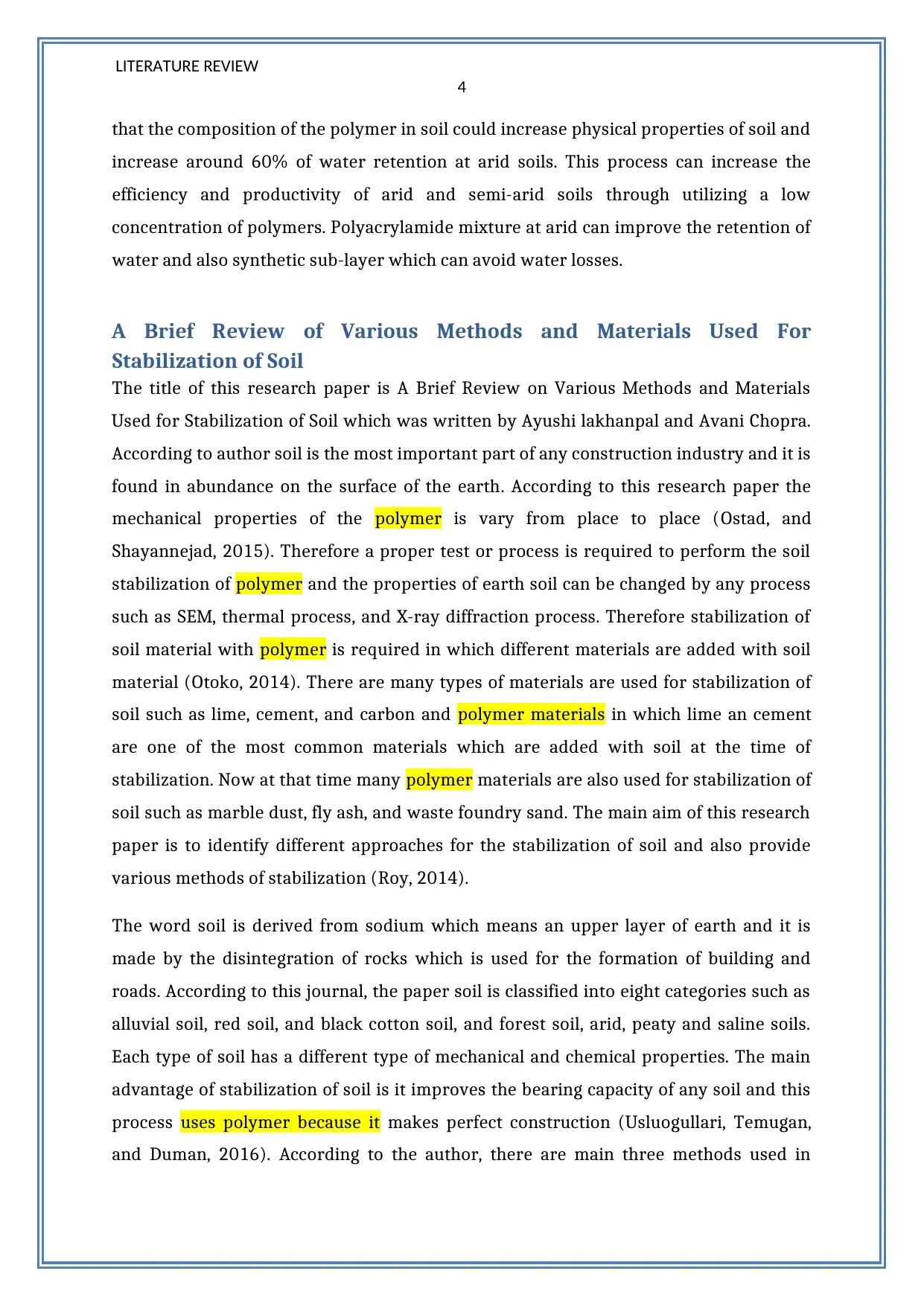
LITERATURE REVIEW
4
that the composition of the polymer in soil could increase physical properties of soil and
increase around 60% of water retention at arid soils. This process can increase the
efficiency and productivity of arid and semi-arid soils through utilizing a low
concentration of polymers. Polyacrylamide mixture at arid can improve the retention of
water and also synthetic sub-layer which can avoid water losses.
A Brief Review of Various Methods and Materials Used For
Stabilization of Soil
The title of this research paper is A Brief Review on Various Methods and Materials
Used for Stabilization of Soil which was written by Ayushi lakhanpal and Avani Chopra.
According to author soil is the most important part of any construction industry and it is
found in abundance on the surface of the earth. According to this research paper the
mechanical properties of the polymer is vary from place to place (Ostad, and
Shayannejad, 2015). Therefore a proper test or process is required to perform the soil
stabilization of polymer and the properties of earth soil can be changed by any process
such as SEM, thermal process, and X-ray diffraction process. Therefore stabilization of
soil material with polymer is required in which different materials are added with soil
material (Otoko, 2014). There are many types of materials are used for stabilization of
soil such as lime, cement, and carbon and polymer materials in which lime an cement
are one of the most common materials which are added with soil at the time of
stabilization. Now at that time many polymer materials are also used for stabilization of
soil such as marble dust, fly ash, and waste foundry sand. The main aim of this research
paper is to identify different approaches for the stabilization of soil and also provide
various methods of stabilization (Roy, 2014).
The word soil is derived from sodium which means an upper layer of earth and it is
made by the disintegration of rocks which is used for the formation of building and
roads. According to this journal, the paper soil is classified into eight categories such as
alluvial soil, red soil, and black cotton soil, and forest soil, arid, peaty and saline soils.
Each type of soil has a different type of mechanical and chemical properties. The main
advantage of stabilization of soil is it improves the bearing capacity of any soil and this
process uses polymer because it makes perfect construction (Usluogullari, Temugan,
and Duman, 2016). According to the author, there are main three methods used in
4
that the composition of the polymer in soil could increase physical properties of soil and
increase around 60% of water retention at arid soils. This process can increase the
efficiency and productivity of arid and semi-arid soils through utilizing a low
concentration of polymers. Polyacrylamide mixture at arid can improve the retention of
water and also synthetic sub-layer which can avoid water losses.
A Brief Review of Various Methods and Materials Used For
Stabilization of Soil
The title of this research paper is A Brief Review on Various Methods and Materials
Used for Stabilization of Soil which was written by Ayushi lakhanpal and Avani Chopra.
According to author soil is the most important part of any construction industry and it is
found in abundance on the surface of the earth. According to this research paper the
mechanical properties of the polymer is vary from place to place (Ostad, and
Shayannejad, 2015). Therefore a proper test or process is required to perform the soil
stabilization of polymer and the properties of earth soil can be changed by any process
such as SEM, thermal process, and X-ray diffraction process. Therefore stabilization of
soil material with polymer is required in which different materials are added with soil
material (Otoko, 2014). There are many types of materials are used for stabilization of
soil such as lime, cement, and carbon and polymer materials in which lime an cement
are one of the most common materials which are added with soil at the time of
stabilization. Now at that time many polymer materials are also used for stabilization of
soil such as marble dust, fly ash, and waste foundry sand. The main aim of this research
paper is to identify different approaches for the stabilization of soil and also provide
various methods of stabilization (Roy, 2014).
The word soil is derived from sodium which means an upper layer of earth and it is
made by the disintegration of rocks which is used for the formation of building and
roads. According to this journal, the paper soil is classified into eight categories such as
alluvial soil, red soil, and black cotton soil, and forest soil, arid, peaty and saline soils.
Each type of soil has a different type of mechanical and chemical properties. The main
advantage of stabilization of soil is it improves the bearing capacity of any soil and this
process uses polymer because it makes perfect construction (Usluogullari, Temugan,
and Duman, 2016). According to the author, there are main three methods used in
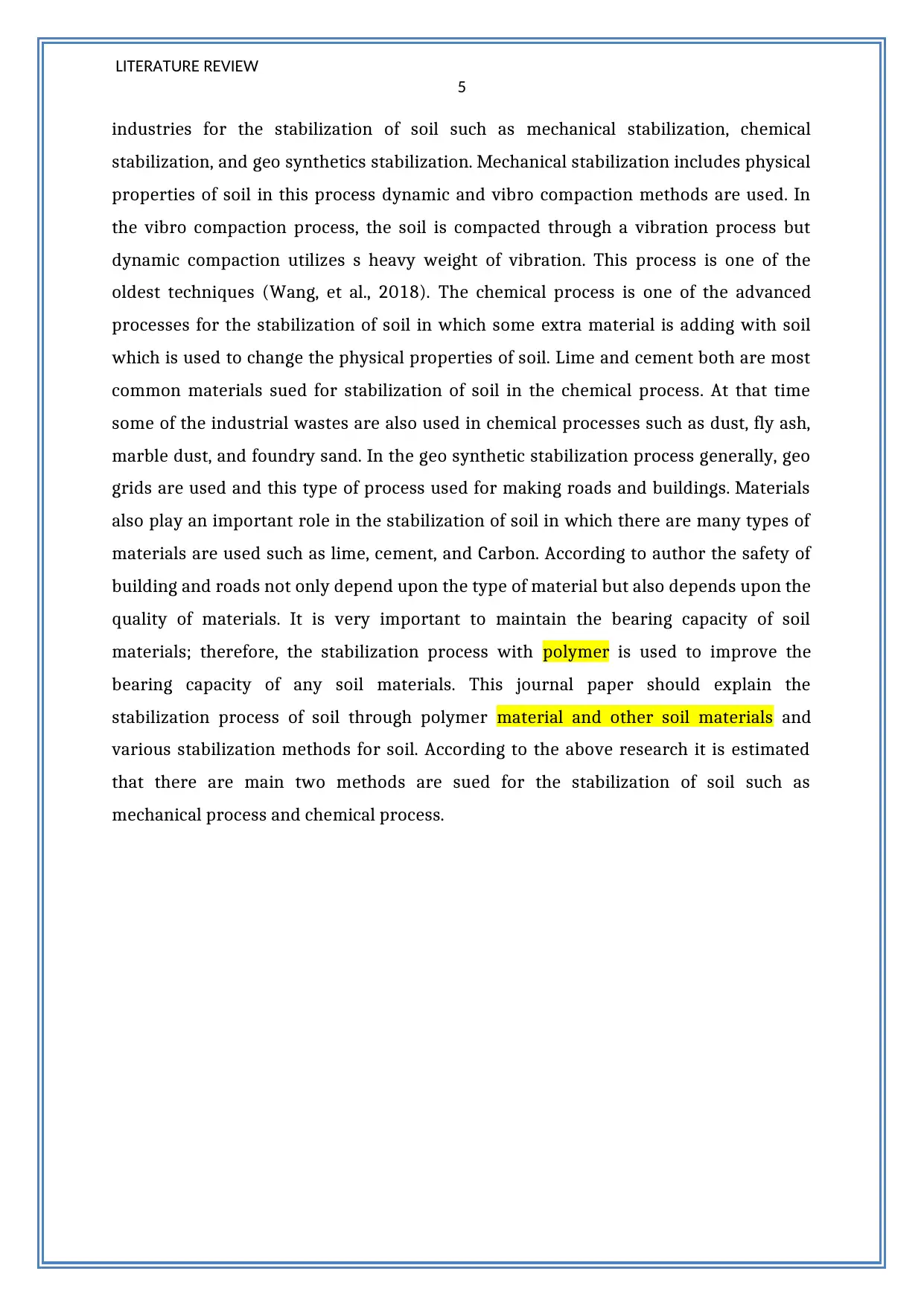
LITERATURE REVIEW
5
industries for the stabilization of soil such as mechanical stabilization, chemical
stabilization, and geo synthetics stabilization. Mechanical stabilization includes physical
properties of soil in this process dynamic and vibro compaction methods are used. In
the vibro compaction process, the soil is compacted through a vibration process but
dynamic compaction utilizes s heavy weight of vibration. This process is one of the
oldest techniques (Wang, et al., 2018). The chemical process is one of the advanced
processes for the stabilization of soil in which some extra material is adding with soil
which is used to change the physical properties of soil. Lime and cement both are most
common materials sued for stabilization of soil in the chemical process. At that time
some of the industrial wastes are also used in chemical processes such as dust, fly ash,
marble dust, and foundry sand. In the geo synthetic stabilization process generally, geo
grids are used and this type of process used for making roads and buildings. Materials
also play an important role in the stabilization of soil in which there are many types of
materials are used such as lime, cement, and Carbon. According to author the safety of
building and roads not only depend upon the type of material but also depends upon the
quality of materials. It is very important to maintain the bearing capacity of soil
materials; therefore, the stabilization process with polymer is used to improve the
bearing capacity of any soil materials. This journal paper should explain the
stabilization process of soil through polymer material and other soil materials and
various stabilization methods for soil. According to the above research it is estimated
that there are main two methods are sued for the stabilization of soil such as
mechanical process and chemical process.
5
industries for the stabilization of soil such as mechanical stabilization, chemical
stabilization, and geo synthetics stabilization. Mechanical stabilization includes physical
properties of soil in this process dynamic and vibro compaction methods are used. In
the vibro compaction process, the soil is compacted through a vibration process but
dynamic compaction utilizes s heavy weight of vibration. This process is one of the
oldest techniques (Wang, et al., 2018). The chemical process is one of the advanced
processes for the stabilization of soil in which some extra material is adding with soil
which is used to change the physical properties of soil. Lime and cement both are most
common materials sued for stabilization of soil in the chemical process. At that time
some of the industrial wastes are also used in chemical processes such as dust, fly ash,
marble dust, and foundry sand. In the geo synthetic stabilization process generally, geo
grids are used and this type of process used for making roads and buildings. Materials
also play an important role in the stabilization of soil in which there are many types of
materials are used such as lime, cement, and Carbon. According to author the safety of
building and roads not only depend upon the type of material but also depends upon the
quality of materials. It is very important to maintain the bearing capacity of soil
materials; therefore, the stabilization process with polymer is used to improve the
bearing capacity of any soil materials. This journal paper should explain the
stabilization process of soil through polymer material and other soil materials and
various stabilization methods for soil. According to the above research it is estimated
that there are main two methods are sued for the stabilization of soil such as
mechanical process and chemical process.
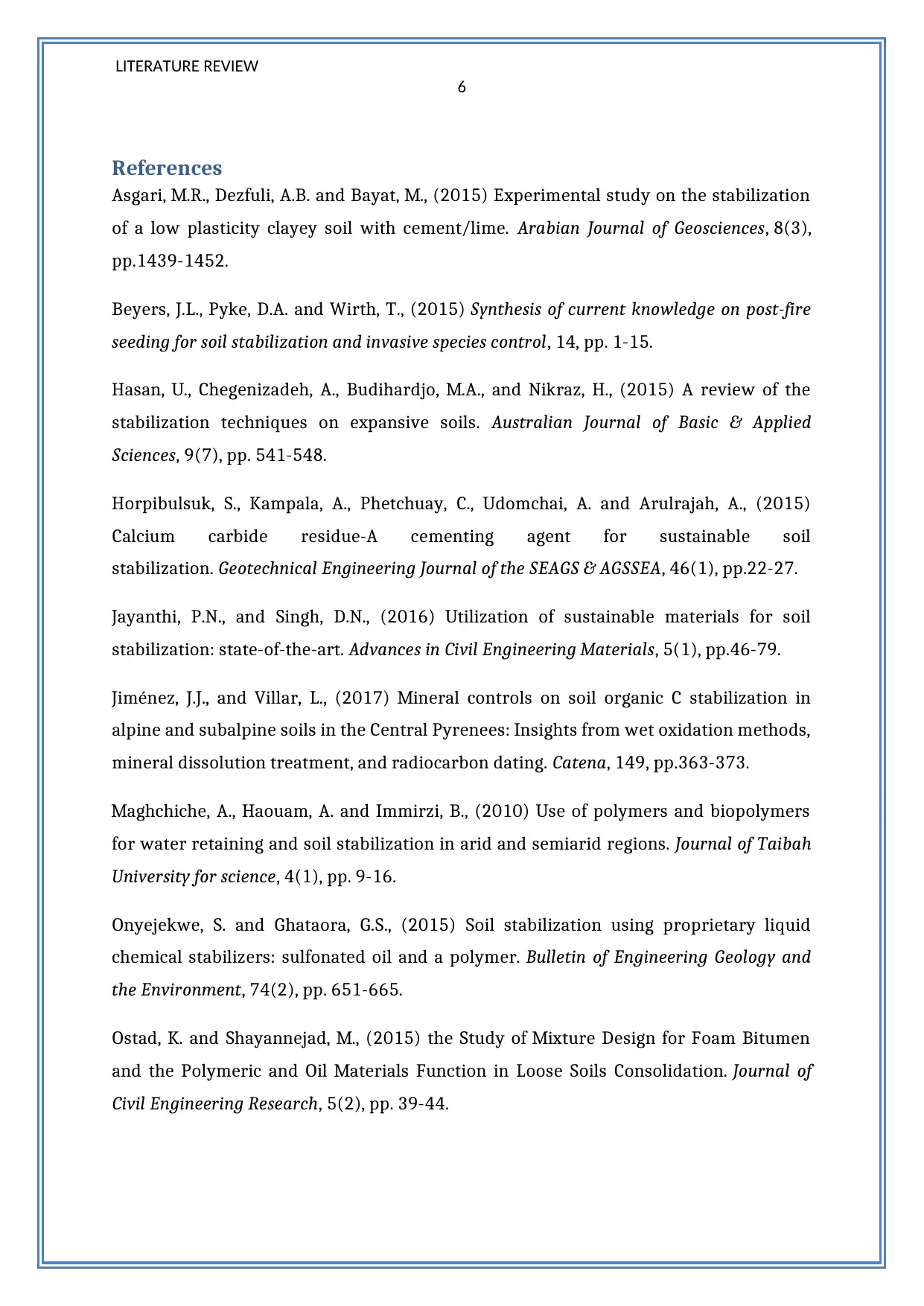
LITERATURE REVIEW
6
References
Asgari, M.R., Dezfuli, A.B. and Bayat, M., (2015) Experimental study on the stabilization
of a low plasticity clayey soil with cement/lime. Arabian Journal of Geosciences, 8(3),
pp.1439-1452.
Beyers, J.L., Pyke, D.A. and Wirth, T., (2015) Synthesis of current knowledge on post-fire
seeding for soil stabilization and invasive species control, 14, pp. 1-15.
Hasan, U., Chegenizadeh, A., Budihardjo, M.A., and Nikraz, H., (2015) A review of the
stabilization techniques on expansive soils. Australian Journal of Basic & Applied
Sciences, 9(7), pp. 541-548.
Horpibulsuk, S., Kampala, A., Phetchuay, C., Udomchai, A. and Arulrajah, A., (2015)
Calcium carbide residue-A cementing agent for sustainable soil
stabilization. Geotechnical Engineering Journal of the SEAGS & AGSSEA, 46(1), pp.22-27.
Jayanthi, P.N., and Singh, D.N., (2016) Utilization of sustainable materials for soil
stabilization: state-of-the-art. Advances in Civil Engineering Materials, 5(1), pp.46-79.
Jiménez, J.J., and Villar, L., (2017) Mineral controls on soil organic C stabilization in
alpine and subalpine soils in the Central Pyrenees: Insights from wet oxidation methods,
mineral dissolution treatment, and radiocarbon dating. Catena, 149, pp.363-373.
Maghchiche, A., Haouam, A. and Immirzi, B., (2010) Use of polymers and biopolymers
for water retaining and soil stabilization in arid and semiarid regions. Journal of Taibah
University for science, 4(1), pp. 9-16.
Onyejekwe, S. and Ghataora, G.S., (2015) Soil stabilization using proprietary liquid
chemical stabilizers: sulfonated oil and a polymer. Bulletin of Engineering Geology and
the Environment, 74(2), pp. 651-665.
Ostad, K. and Shayannejad, M., (2015) the Study of Mixture Design for Foam Bitumen
and the Polymeric and Oil Materials Function in Loose Soils Consolidation. Journal of
Civil Engineering Research, 5(2), pp. 39-44.
6
References
Asgari, M.R., Dezfuli, A.B. and Bayat, M., (2015) Experimental study on the stabilization
of a low plasticity clayey soil with cement/lime. Arabian Journal of Geosciences, 8(3),
pp.1439-1452.
Beyers, J.L., Pyke, D.A. and Wirth, T., (2015) Synthesis of current knowledge on post-fire
seeding for soil stabilization and invasive species control, 14, pp. 1-15.
Hasan, U., Chegenizadeh, A., Budihardjo, M.A., and Nikraz, H., (2015) A review of the
stabilization techniques on expansive soils. Australian Journal of Basic & Applied
Sciences, 9(7), pp. 541-548.
Horpibulsuk, S., Kampala, A., Phetchuay, C., Udomchai, A. and Arulrajah, A., (2015)
Calcium carbide residue-A cementing agent for sustainable soil
stabilization. Geotechnical Engineering Journal of the SEAGS & AGSSEA, 46(1), pp.22-27.
Jayanthi, P.N., and Singh, D.N., (2016) Utilization of sustainable materials for soil
stabilization: state-of-the-art. Advances in Civil Engineering Materials, 5(1), pp.46-79.
Jiménez, J.J., and Villar, L., (2017) Mineral controls on soil organic C stabilization in
alpine and subalpine soils in the Central Pyrenees: Insights from wet oxidation methods,
mineral dissolution treatment, and radiocarbon dating. Catena, 149, pp.363-373.
Maghchiche, A., Haouam, A. and Immirzi, B., (2010) Use of polymers and biopolymers
for water retaining and soil stabilization in arid and semiarid regions. Journal of Taibah
University for science, 4(1), pp. 9-16.
Onyejekwe, S. and Ghataora, G.S., (2015) Soil stabilization using proprietary liquid
chemical stabilizers: sulfonated oil and a polymer. Bulletin of Engineering Geology and
the Environment, 74(2), pp. 651-665.
Ostad, K. and Shayannejad, M., (2015) the Study of Mixture Design for Foam Bitumen
and the Polymeric and Oil Materials Function in Loose Soils Consolidation. Journal of
Civil Engineering Research, 5(2), pp. 39-44.
Paraphrase This Document
Need a fresh take? Get an instant paraphrase of this document with our AI Paraphraser
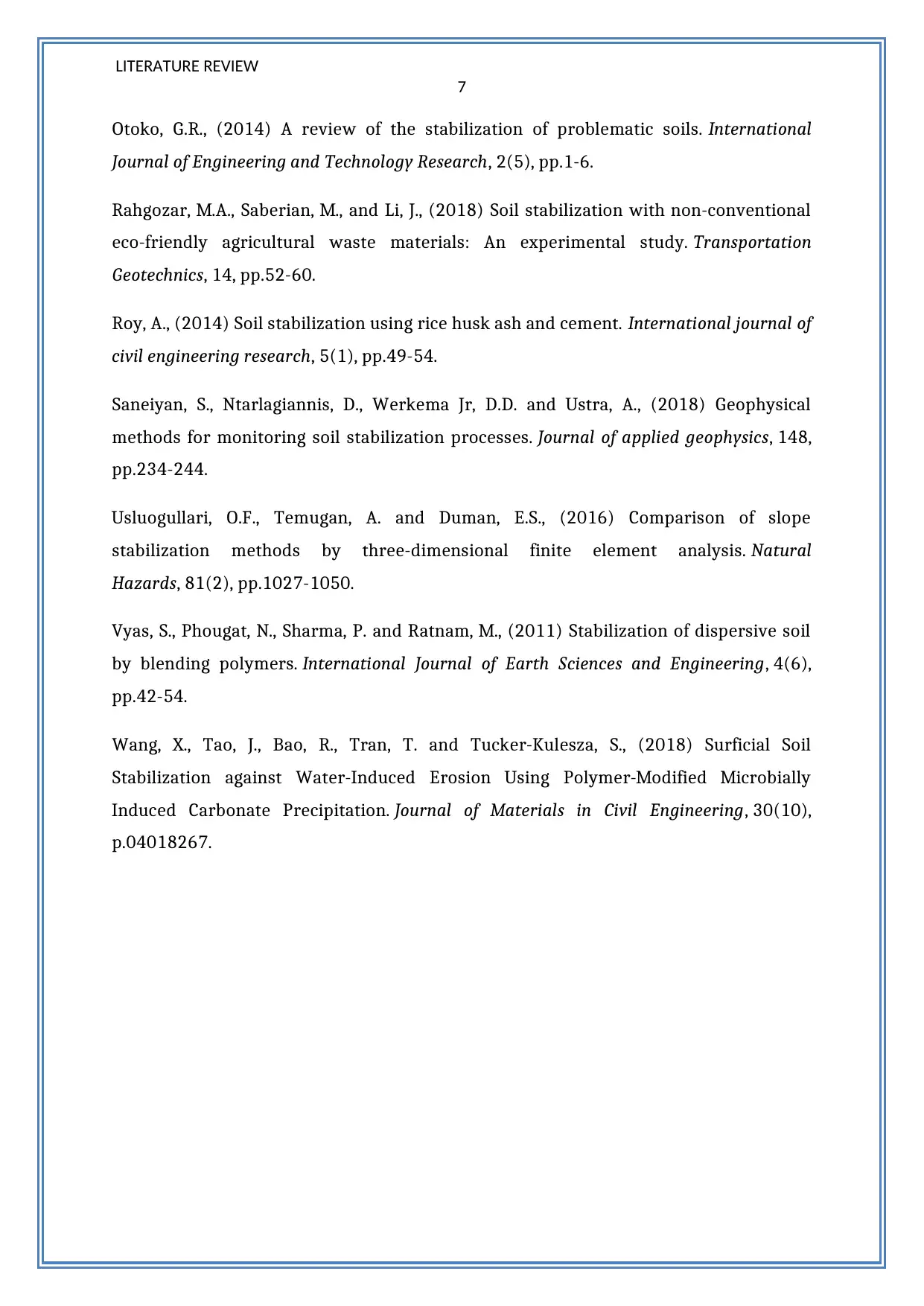
LITERATURE REVIEW
7
Otoko, G.R., (2014) A review of the stabilization of problematic soils. International
Journal of Engineering and Technology Research, 2(5), pp.1-6.
Rahgozar, M.A., Saberian, M., and Li, J., (2018) Soil stabilization with non-conventional
eco-friendly agricultural waste materials: An experimental study. Transportation
Geotechnics, 14, pp.52-60.
Roy, A., (2014) Soil stabilization using rice husk ash and cement. International journal of
civil engineering research, 5(1), pp.49-54.
Saneiyan, S., Ntarlagiannis, D., Werkema Jr, D.D. and Ustra, A., (2018) Geophysical
methods for monitoring soil stabilization processes. Journal of applied geophysics, 148,
pp.234-244.
Usluogullari, O.F., Temugan, A. and Duman, E.S., (2016) Comparison of slope
stabilization methods by three-dimensional finite element analysis. Natural
Hazards, 81(2), pp.1027-1050.
Vyas, S., Phougat, N., Sharma, P. and Ratnam, M., (2011) Stabilization of dispersive soil
by blending polymers. International Journal of Earth Sciences and Engineering, 4(6),
pp.42-54.
Wang, X., Tao, J., Bao, R., Tran, T. and Tucker-Kulesza, S., (2018) Surficial Soil
Stabilization against Water-Induced Erosion Using Polymer-Modified Microbially
Induced Carbonate Precipitation. Journal of Materials in Civil Engineering, 30(10),
p.04018267.
7
Otoko, G.R., (2014) A review of the stabilization of problematic soils. International
Journal of Engineering and Technology Research, 2(5), pp.1-6.
Rahgozar, M.A., Saberian, M., and Li, J., (2018) Soil stabilization with non-conventional
eco-friendly agricultural waste materials: An experimental study. Transportation
Geotechnics, 14, pp.52-60.
Roy, A., (2014) Soil stabilization using rice husk ash and cement. International journal of
civil engineering research, 5(1), pp.49-54.
Saneiyan, S., Ntarlagiannis, D., Werkema Jr, D.D. and Ustra, A., (2018) Geophysical
methods for monitoring soil stabilization processes. Journal of applied geophysics, 148,
pp.234-244.
Usluogullari, O.F., Temugan, A. and Duman, E.S., (2016) Comparison of slope
stabilization methods by three-dimensional finite element analysis. Natural
Hazards, 81(2), pp.1027-1050.
Vyas, S., Phougat, N., Sharma, P. and Ratnam, M., (2011) Stabilization of dispersive soil
by blending polymers. International Journal of Earth Sciences and Engineering, 4(6),
pp.42-54.
Wang, X., Tao, J., Bao, R., Tran, T. and Tucker-Kulesza, S., (2018) Surficial Soil
Stabilization against Water-Induced Erosion Using Polymer-Modified Microbially
Induced Carbonate Precipitation. Journal of Materials in Civil Engineering, 30(10),
p.04018267.
1 out of 8
Related Documents
Your All-in-One AI-Powered Toolkit for Academic Success.
+13062052269
info@desklib.com
Available 24*7 on WhatsApp / Email
![[object Object]](/_next/static/media/star-bottom.7253800d.svg)
Unlock your academic potential
© 2024 | Zucol Services PVT LTD | All rights reserved.



